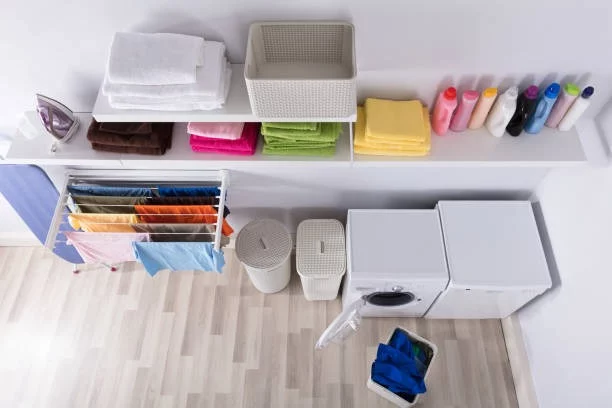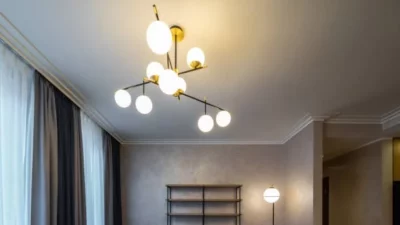Last Updated on July 12, 2025 by Lexy Summer
Laundry rooms are hardworking spaces that deal with a lot of moisture. From leaky washers to humid air, water can be a real problem here. That’s why choosing the right materials, like durable waterproof vinyl floor options, is key to keeping things dry and efficient.
Why Moisture Management Matters
Laundry rooms often experience unexpected spills or overflows. Even a small leak can cause damage over time. Moisture can lead to warping, mold, or even structural problems if ignored.
Preventing moisture problems helps protect your home and your belongings. It also extends the life of your machines and surfaces. Dry conditions make the room safer and easier to clean. Thinking ahead saves time and money in the long run. Good design and materials prevent the need for costly repairs. A little planning now pays off later.
Smart Flooring Choices
The floor in your laundry room takes a lot of abuse. Between drips from wet clothes and the vibrations from machines, durability is essential. Your flooring also needs to handle moisture without damage.
Tile and concrete are popular, but can feel cold and hard underfoot. Waterproof vinyl flooring is a smart alternative for something warmer and easier to install. It resists water, looks stylish, and offers a comfortable feel.
Vinyl is also slip-resistant and straightforward to maintain. You can find designs that mimic wood, tile, or stone. Many types are designed for quick installation, making updates easy and affordable.
Moisture-Resistant Wall Surfaces
Walls in a laundry room can take on a lot of humidity. Steam from hot water or damp clothes may create condensation. Protecting your walls from mold and mildew is essential.
Paint is a budget-friendly option, but it must be labeled for high-moisture areas. Standard paint can peel or crack over time. Consider satin or semi-gloss finishes for better moisture resistance.
Another option is to use tile or waterproof panels around high-risk zones. These surfaces are ideal behind machines or near utility sinks and add a finished, modern look to the space.
Storage That Stands Up To Moisture
Storage in a laundry room needs to be practical and resistant to dampness. Solutions that keep items off the floor and out of harm’s way are most important. Moisture-proof materials make the most significant difference.
Cabinets made from moisture-sealed MDF or furniture-grade plywood hold up well. Avoid particleboard, which can swell or break down over time. Floating shelves are also a great way to maximize wall space while keeping things dry.
Use bins or baskets made from plastic, metal, or treated wood. These materials handle humidity better than fabric containers. Keep everything labeled and accessible to simplify your routine.
Don’t Forget The Plumbing
Plumbing is at the heart of every laundry room. Leaks and drips are always a risk, especially with older connections. Regular maintenance is essential to prevent water damage.
Use stainless steel braided hoses for your washer instead of rubber ones. They last longer and are less likely to burst. Check for signs of wear at least once a year.
If the washer is on an upper floor, install a drip pan under it. This catches leaks before they spread. Some setups even include sensors that alert you to excess moisture.
Ventilation: A Must-Have
Good airflow is essential in a laundry room. It helps control humidity and prevents mold. A stuffy space filled with damp clothes can quickly become a problem.
A vented dryer should always lead outside the home. Blockages in the duct can trap moisture and create fire risks. Clean the lint trap and ductwork regularly.
Consider installing a small exhaust fan if the room doesn’t have a window. Some models even have humidity sensors that turn on automatically. These features help maintain a dry environment with minimal effort.
Simple Design, Big Impact
Sometimes, it’s the small decisions that make the most significant difference. Consider raising appliances off the ground slightly. This makes cleaning easier and protects the floor.
Seal gaps with water-resistant baseboards and corner trim. Silicone caulk around the edges adds an extra layer of protection. Every detail helps keep water where it belongs.
Finally, plan for easy access. Avoid placing heavy shelves or cabinets directly over machines. Leave space for maintenance and allow air to flow freely around appliances.
Conclusion
A dry, well-organized laundry room doesn’t happen by accident. It starts with wise choices like durable waterproof vinyl floor options and moisture-resistant surfaces. These simple upgrades make your space safer and easier to use every day.
To ensure your laundry room remains dry and functional, it’s crucial to address any underlying issues that may compromise its integrity. One often overlooked aspect is the condition of the subfloor, which can be susceptible to moisture damage over time. Investing in professional subfloor repairs by Valley Crawlspace can prevent potential water damage and maintain the structural soundness of your laundry area. By addressing these foundational concerns, you can create a more resilient space that withstands the demands of daily use, ensuring your laundry room remains both practical and aesthetically pleasing.

Lexy Summer is a talented writer with a deep passion for the art of language and storytelling. With a background in editing and content creation, Lexy has honed her skills in crafting clear, engaging, and grammatically flawless writing.



